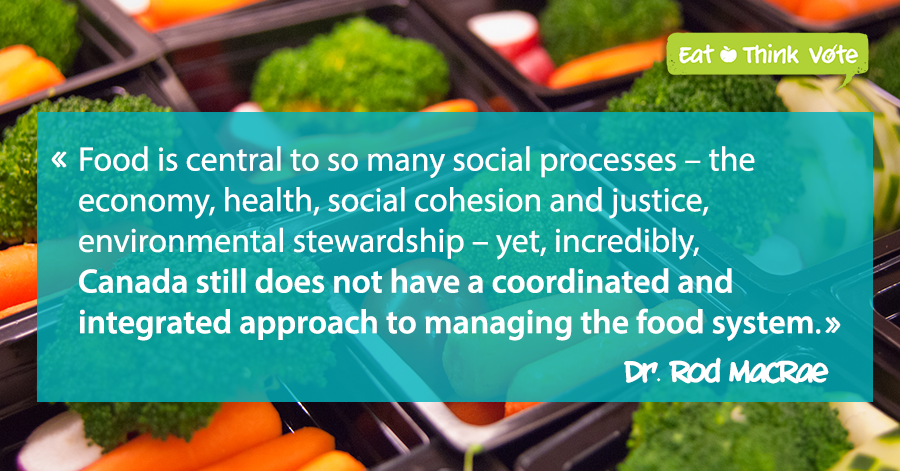A National Food Policy Council for Canada
October 16, 2015

Food policy in Canada on a national level is like the puzzle pieces your bratty kid brother scattered all over the living room floor when you were younger. Some of the pieces are there, others are missing, and none of it resembles a complete picture. Food policy analyst Dr. Rod MacRae argues in his latest article for Food Secure Canada that Canada could put this national food policy puzzle together by creating a national food policy council similar to the dozens of municipal food policy councils successfully operating in Canada today.
Read MacRae’s article on the benefits of having a coherent and comprehensive national food policy and the dangers of failing to create one.
The following was written by Dr. Rod MacRae, who is Assistant Professor Faculty of Environmental Studies at York University. His research focuses on creating a national food agriculture policy for Canada, and the set of coherent and comprehensive programs required to support such a policy.

Food is central to so many social processes – the economy, health, social cohesion and justice, environmental stewardship – yet, incredibly, Canada still does not have a coordinated and integrated approach to managing the food system. Pieces of what we need exist, but these are poorly linked and many holes remain in the architecture of a joined up food policy.
By joined up food policy, I mean the coherent and comprehensive policy environment that links food system function and behaviour to the goals of health promotion, social justice and environmental sustainability. A joined-up policy unites activities across all pertinent domains, scales, actors and jurisdictions. It employs a wide range of tools and governance structures to deliver these goals, including sub-policies, legislation, regulations, regulatory protocols and directives, programs, educational mechanisms, taxes or tax incentives, and changes to how and where decisions are made.
Because of our disjointed approach, the food system creates all kinds of problems that get limited attention from governments. There’s lots of food in the shops, but we also have:
Hunger in a land of plenty - some 10% of Canadians can’t afford a nourishing diet even though there’s lots of food to go round
A focus on export when regional economy experts tell us that import substitution produces more economic activity and jobs than does exports - Canada imports 30% of what we consume and probably half of that is foods we can produce and store here.
Many farms only survive because somebody in the family is working off the farm – the boom and bust cycles of most farming sectors mean farm income is highly variable and farms continue to go under at an alarming rate.
Many diseases and conditions have diet as a major risk factor but very little attention is paid to food as a health promotion strategy – nothing says disjointed food policy more strongly than the combination of doctors who understand little about food and food companies that only provide unhealthy products.
Farms and food companies are major contributors to air and water pollution when they can be substantial mitigators of these problems – governments know where the environmental hotspots are but are doing little to help farms and firms become great environmental stewards.
A joined up food policy creates the framework, mandate and implementation plan for solving these, and other problems.
Creating a joined up food policy is admittedly challenging:
- it’s about the intersections between policy systems that are historically divided intellectually, constitutionally and departmentally
- governments have no obvious institutional place from which to work, and the instruments of multi-departmental policy making are in their infancy; there is no department of food
- supporting new approaches means extensively confronting many existing and entrenched policy traditions
- it means having to address the real costs of conventional food, health, economic and social systems
- it means understanding food as more than a marketable commodity, which creates problems for certain departments
- it challenges many of the central tenets of current agricultural and economic development, and health care system that concentrates on cures rather than prevention.
The good news is that a joined up approach is not something completely new in Canada, we had it during WWII. Governments recognized that the market place would fail and put in place a wide array of programs and regulations to ensure basic population health and to meet our food supply obligations to allies in the war. As part of this, an extensive array of new governance mechanisms were created, producing extensive collaborations across government and the private sector, including NGOs. Such governance mechanisms were central to the design and execution of the interventions. Unfortunately, most of them were dismantled right after the war ended.
One way to get us back on track is with a national Food Policy Council (FPC). Dozens of these councils already exist at municipal and provincial levels across the country. A food policy council is a place for stakeholders who rarely talk to each other to gather and propose solutions to chronic food system problems. When well linked to government, they can help elected and unelected officials find ways to act on win-win scenarios. The potential structure, membership and budget of such a body have already been thought through by researcher Sasha McNicoll. My hope is that the new government will act quickly to construct a national FPC, with the mandate to propose a joined up food policy for Canada and assist with its implementation.
Listen to the webinar Food Secure Canada hosted on a national food policy council on September 25th, 2015 and learn more.
- Log in to post comments

